| |
|
|
| |
Examples of Miniature Medal Bars
Awarded to German Colonial and
Overseas Veterans
Below are a number of
miniature ribbon bars, all have either the 1900-01 China Campaign
Medal, the 1904-08 South West African Campaign Medal, the Colonial
Service Medal or other awards for overseas service. It should be noted that it is not always possible to
tell from miniature ribbons what class a medal was awarded in or if
it was a combatant or non-combatant award. Campaign clasps were rarely used
on miniature ribbons.
For more on the
individual medals and awards see the Medals Page. Please
respect the generosity of the owners of these bars in
sharing these photographs with us by not reproducing them
without prior permission.
|
|
| |
|
|
| |
|
|
| |
|
|
| |
Bar with the China
and Colonial Medals and
Ottoman Awards

Photo © JW Collection
The medals on this bar in order of
seniority from left to right are-
Prussian Iron Cross,
second class
Hamburg Hanseatic Cross
1914-18 Honour Cross with swords
1900-01 China Campaign Medal
Colonial Service Medal
Prussian
Officers Long Service Award, for 25 years service
Prussian Order of the Red Eagle, judging by its position on the
bar it would probably be a pre-war award without swords
Prussian Landwehr
Long Service Award
Prussian Wilhelm I Centenary Medal
Ottoman Liyakat Merit
Medal in silver with swords
Ottoman War Medal
The original owner of this miniature ribbon bar was an officer
veteran of the Boxer Rebellion, an unspecified colonial campaign and
the First World War, when
he served alongside Ottoman forces in the Middle East. Judging
from the varied overseas medals and the Hamburg Hanseatic Cross, he
may well have been a naval officer, possibly serving on the SMS Goeben or SMS Breslau in Ottoman service from 1914.
|
|
| |
|
|
| |
|
|
| |
|
|
| |
Bar with the Colonial
and South West Africa Medals

Photo © JW Collection
The medals on this bar in order of seniority
from left to right are-
Prussian Iron Cross, second class
Saxon Albert Order,
Knights Cross second class with swords
Prussian Order of the Red Eagle, probably fourth class
Prussian
Officers Long Service Award
Colonial
Service Medal
1904-08 South West Africa Campaign Medal
Prussian
Wilhelm I Centenary Medal,
although it is missing from the front, the
ribbon can still be seen on the back of the bar
The
original owner of this miniature ribbon bar was a Saxon officer veteran of
the Herero Rebellion, an unspecified Colonial campaign and the First World
War. Judging from the Prussian rather than Saxon long service award, this
officer spent his career in Imperial (Navy, Marine Infantry or Schutztruppe) rather than
Saxon army service. |
|
| |
|
|
| |
|
|
| |
|
|
| |
Bar with the Colonial and South
West Africa Medals

Photo © JW Collection
The medals on this bar in order of
seniority from left to right are-
Prussian Iron
Cross, second class
Saxon Albert Order,
Knights Cross second class with swords
1914-18 Honour Cross with
swords
Colonial Service Medal
1904-08 South West Africa Campaign Medal
The original owner
of this miniature ribbon bar was probably a Saxon officer and was a veteran of the Herero Rebellion,
another unspecified colonial campaign and the First World War.
|
|
| |
|
|
| |
|
|
| |
|
|
| |
Bar with the Colonial Medal

Photo © JW Collection
The medals on this bar in order of
seniority from left to right are-
Prussian Iron Cross, second class
Honour Cross with swords
Prussian
Other Ranks Long Service Award
Colonial Service Medal
The original owner of this
miniature ribbon
bar was an other ranks veteran of an unspecified colonial campaign and the First
World War.
|
|
| |
|
|
| |
|
|
| |
|
|
| |
Bar with
the Colonial Medal

Photo © JW Collection
The medals on this bar in order of
seniority from left to right are-
Prussian Iron Cross, second class
Prussian Order of the Red Eagle
1914-18
Honour Cross with swords
Colonial Service Medal
Prussian
Officers Long Service Award
Prussian Landwehr Long Service Award
The original owner of this miniature ribbon bar was a
officer veteran of an
unspecified colonial campaign and the First World War.
|
|
| |
|
|
| |
|
|
| |
|
|
| |
Bar with the Colonial Medal

Photo © JW Collection
The medals on this bar in order of
seniority from left to right are-
Prussian Crown Order, fourth class with swords
Prussian Order of the Red Eagle, fourth
class
Colonial Service Medal
Prussian Lifesaving
Medal
The original owner of this miniature ribbon bar was an officer
veteran of an unspecified colonial campaign.
|
|
| |
|
|
| |
|
|
| |
|
|
| |
Bar with
the South West Africa Medal

Photo © JW Collection
The medals on this bar in order of
seniority from left to right are-
Prussian Iron Cross, second class
Prussian Warriors Merit Medal
1914-18 Honour Cross with swords
Baden Silver Merit
Medal
1904-08 South West Africa Campaign Medal
Bremen Hanseatic
Cross
Silesian Eagle
Finnish Bravery
Medal
The original owner of this miniature ribbon bar was a Baden veteran
of the Herero Rebellion, the First
World War and
the following Freikorps campaigns in Silesia.
|
|
| |
|
|
| |
|
|
| |
|
|
| |
Bar with
the Colonial and South West Africa Medals

Photo © Anton
Veltman
The medals on this bar in order of
seniority from left to right are-
Prussian Iron Cross, second class
Prussian Warriors Merit Medal
Prussian Merit Cross for War
Aid
Colonial Service Medal
1904-08 South West Africa Campaign Medal
Prussian Wilhelm I Centenary Medal
Brunswick War Merit
Cross
The original owner of this miniature ribbon bar was
a veteran
of the Herero Rebellion, an unspecified colonial campaign and the First
World War.
The Brunswick medal indicates that the owner was either from
Brunswick or possibly served in a Brunswick army unit prior to his colonial
service. |
|
| |
|
|
| |
|
|
| |
|
|
| |
Bar with
the South West Africa Medal

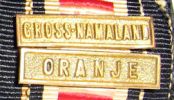
Photo © Chris Handisides Collection
The medals on this bar in order of
seniority from left to right are-
Prussian Iron Cross, second class
Prussian Crown Order
with swords
1904-08 South West Africa Campaign Medal,
with clasps for "GROSS-NAMALAND" and "ORANJE"
(see close-up
photo on the right)
The original owner of this miniature ribbon bar was a
combatant officer
veteran of two campaigns in the Herero Rebellion (or more
particularly the campaign against the Nama considering his clasps) and the First World War.
It is rare to see miniature campaign clasps.
|
|
| |
|
|
| |
|
|
| |
|
|
| |
Bar with
the South West Africa Medal

Photo © JW Collection
The medals on this bar in order of
seniority from left to right are-
Prussian Iron Cross, second class
Prussian Crown Order,
probably fourth class and with swords
Hamburg Hanseatic Cross
Oldenburg Friedrich August Cross, second class
Prussian Order of the
Red Eagle, fourth class peacetime award
1904-08 South West Africa Campaign Medal
Silesian Eagle,
second class
Prussian Officers Long
Service Award, for 25 years service
The original owner of
this miniature ribbon bar was a naval officer and veteran of
the Herero Rebellion, the First World War and the Freikorps
campaign against Polish nationalists in Silesia. Note the
commonplace awarding of medals from the coastal states of
Hamburg and Oldenburg to a naval officer. As awards earned
in the 1914-18 War they outranked the earlier Prussian Red Eagle and
South West Africa despite being
It is possible that
the second medal on the bar could be another
Prussian Order of the
Red Eagle awarded in wartime. In peacetime the Crown Order
had a blue ribbon and the Order of the
Red Eagle had a red and white ribbon (as seen here in fifth
place).
|
|
| |
|
|
| |
|
|
| |
|
|
| |
Bar with
the South West Africa Medal

Photo © JW Collection
The medals on this bar in order of
seniority from left to right are-
Prussian Iron Cross, second class
Württemberg Friedrich Order
Knights Cross, second class with Swords
Württemberg Silver Bravery
Medal or Military Merit Order
Württemberg Long Service Award
1904-08 South West Africa Campaign Medal
German Legion
of Honour Medal
The original owner of this miniature ribbon bar was a Württemberg
veteran of the Herero Rebellion and the First World War. Prior to
the First World War Württemberg regulations required that senior
medals always replaced junior ones. During the war these regulations
were relaxed so that Württemberg soldiers could wear several
Württemberg awards at the same time as seen here.
The Honour Medal for
the World War Legion of Honour ("Ehrendenkmünze
des Weltkrieges der Deutschen Ehrenlegion") was
instituted in 1921 by the "Verband national gesinnter
Soldaten“ veterans organisation for purchase by war
veterans. It was an unofficial award and was banned in 1934.
|
|
| |
|
|
| |
|
|
| |
|
|
| |
Bar with the
South West Africa Medal

Photo © JW Collection
The medals on this bar in order of seniority
from left to right are-
Prussian Iron Cross, second class
Brunswick War Merit Cross
1914-18
Honour Cross without swords
1904-08 South West Africa Campaign Medal
Prussian Long
Service Award
Austro-Hungarian Order of Military Merit,
third class
The
original owner of this miniature ribbon bar was a Brunswick officer veteran of the
Herero Rebellion and the First World War. This bar can be quite accurately
dated. It has the Honour Cross instituted in 1934 and yet keeps the Austrian
medal in final place as a foreign medal. From 1938 Austrian medals were
worn with equal ranking to German ones. The Austro-Hungarian Order of
Military Merit was only awarded to officers.
|
|
| |
|
|
| |
|
|
| |
|
|
| |
Bar with the South
West Africa Medal

Photo © JW Collection
The medals on this bar in order of seniority
from left to right are-
Prussian Iron Cross, second class
Hessian General Decoration
1904-08 South West Africa Campaign Medal
Hessian Long Service Cross
Hessian
Philip the Magnanimous Knights Cross, without swords
The
original owner of this miniature ribbon bar was a Hessian Officer veteran of the Herero Rebellion
and the First World War. The
Philip the Magnanimous Knights Cross was
only awarded to officers. Note the South German style of folding the
ribbons. This and
his wearing of a Hessian rather than a Prussian
long service award would imply that he was not a regular member of the
Schutztruppe but of the Hessian contingent of the Prussian Army. He may have
served in the Schutztruppe only for the duration of the Herero Rebellion, or
may have earned his South West African Medal as a non-combatant. |
|
| |
|
|
| |
|
|
| |
|
|
| |
Bar with the South
West Africa Medal

Photo © JW Collection
The medals on this bar in order of seniority
from left to right are-
Prussian Iron Cross, second class
1914-18 Honour
Cross without swords
1904-08 South West Africa Campaign Medal
Prussian Long
Service Award
The
original owner of this miniature ribbon bar was veteran of the Herero
Rebellion and the First World War. |
|
| |
|
|
| |
|
|
| |
|
|
| |
Bar with
the South West Africa Medal

Photo © JW Collection
The medals on this bar in order of
seniority from left to right are-
Prussian Iron Cross, second class
1914-18 Honour Cross with swords
Silesian Eagle
Prussian Long
Service Award
1904-08 South West Africa Campaign Medal
The original owner of this
miniature ribbon bar was
a veteran of the Herero Rebellion, the First World War and the
following Freikorps campaigns in Silesia.
|
|
| |
|
|
| |
|
|
| |
|
|
| |
Bar with the South West
Africa Medal
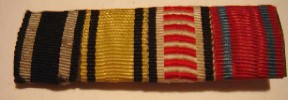
Photo © Doppler Collection
The medals on this bar in order of
seniority from left to right are-
Prussian 1914 Iron Cross, second
class
Württemberg Order of Military
Merit
1904-08 South West Africa Campaign Medal
Württemberg Long Service Medal which was awarded with a medal in in white metal for nine years service or
gilt for twelve
The original owner
of this miniature ribbon bar was a
Württemberg
veteran of the Herero Rebellion and the
First World War. He is reported to have served in the
25th Württemberg Dragoons ("Dragoner-Regt. Königin Olga
(1. Württembergisches) Nr.25").
|
|
| |
|
|
| |
|
|
| |
|
|
| |
Bar with the South West
Africa Medal

Photo © Chris Handisides Collection
The medals on this bar are a very
curious combination, from left to right are-
Nassau 1909 Commemoration Medal
Finnish Cross of Liberty, second class
1904-08 South West Africa Campaign Medal
Dutch Order of Orange-Nassau
Finnish War of Independence Commemorative Award
Prussian Merit
Cross for War Aid
Lippe-Detmold Warriors Merit Cross, second class for
combatants
This is a most interesting medal
bar. The first thing which strikes one is the medals from different
nations and their seeming lack of order of seniority.
For German servicemen from any
state all German awards were to be worn before foreign ones, so the
original owner of this bar is unlikely to have been in German
service at the time of wearing this bar. We'll look at each medal
one by one then try to piece them together. There are a number of
decorations from the Grand Duchy of Nassau that share the
same ribbon, however given the time scale of the other
awards worn by this man the 1909 Commemoration Medal
("Erinnerungsmedaille")
seems the most likely of them. The Grand Duchy of Nassau was
annexed by Prussia after the Austro-Prussian War of 1866,
yet the former heads of state continued to award medals. One
was the 1909 medal to commemorate the last reigning Grand
Duke, Adolphe of Nassau
(1817-1905), who after being deposed in Nassau inherited the
Grand Duchy of Luxembourg. The medal was awarded in silver to members of
the former Grand Duke's retinue and officers of his army,
and in bronze to NCOs and other ranks.
Recommended External Links -
Weitze-
Erinnerungsmedaille
and
Wikipedia- Grand Duke Apolphe
The two Finnish awards show the original owner served in the Finnish
Civil War of
1918, probably as part of the German Baltic
Sea Division protecting Finland's newly won independence from the Red
Army.
Recommended External Link-
Wikipedia.de- Ostsee-Division
The South West Africa Campaign
Medal, as mentioned before, could be awarded to
non-combatants who did useful work supporting Germany's war
effort from back in Europe. The Dutch Order of
Orange-Nassau had no direct relation to the former German
Grand Duchy of Nassau. It was however sometimes awarded to
foreigners such as diplomats, the retinue of visiting
royalty or those who had assisted the Dutch
royal family (for example it was conferred upon many Allied
servicemen for helping liberate Holland during the Second
World War).
Recommended External Link -
Wikipedia- Order of Orange-Nassau
The last two German awards
are for the First World War. The
Prussian Merit
Cross for War Aid shows he contributed to the German War effort in a
non-combatant role, the Lippe-Detmold Warriors Merit Cross
is confusingly for combatants.
So who could possibly have these
different awards and wear them in such an odd order? No one
country's awards outrank the others, the Finns are not all
in front of the Germans, yet the Germans are not all in
front of the Dutch. A possible answer is that this bar is a
second bar, worn below more senior medals from the holders
own current country of service. One plausible scenario would
be if this bar belonged to a German member of the deposed
Grand Duke Adolphe of Nassau's retinue during his time as
Grand Duke of Luxembourg. The Dutch award could be from the
close association of the Luxembourg and Netherlands royal
families and may have been awarded on a state or private
visit. The South West Africa Medal could possibly be awarded
as a non-combatant if the owner simply supported or
facilitated the recruiting of volunteers for the
Schutztruppe from the former Grand Duchy of Nassau, or maybe
raised funds for them. During the First World War Luxembourg
was occupied by Germany, the owner of this bar seems from
his
Prussian Merit
Cross for War Aid to have helped the Germans at this time, probably
being originally German himself. He may have earned the
Lippe-Detmold medal at this time too as the Lippe-Detmold
contingent of the German army, part of the 55th Westphalian
Infantry Regt ("Infanterie-Regiment "Graf Bülow von
Dennewitz" 6. Westfälisches Nr. 55" of the VII.
Armee-Korps) was on the Western Front throughout the war.
The original owner must then have gone with the German
forces to Finland in 1918. After the war he would have
returned to the Grand Duchy of Luxembourg and worn this
collection as his second bar below his Luxembourg awards.
This is of course not certain,
merely a hypothesis that fits the awards. In a further twist
to this mystery, another similar bar but with crossed swords
on the Dutch Order has been seen in another private collection
(see
Wehrmacht Awards Forum). |
|
| |
|
|
| |
|
|
| |
|
|
| |
Bar with
the South West Africa Medal and an Ottoman Award

Photo © JW Collection
The medals on this bar in order of
seniority from left to right are-
Prussian Iron Cross, second class
Prussian Warriors Merit Medal
Hessian General Decoration
1904-08 South West Africa Campaign Medal
1914-18 Honour Cross
Ottoman War Medal
The original owner of this miniature ribbon bar was a Hessian
veteran of an unspecified colonial campaign and the First World War,
when he probably served alongside the Ottoman army in the Middle
East. Curiously he wears his Honour Cross behind his South West
Africa Medal, whereas it would usually take precedence.
|
|
| |
|
|
| |
|
|
| |
|
|
| |
Bar with the China and South
West Africa Medals

Photo © JW Collection
The medals on this bar in order of
seniority from left to right are-
Prussian Iron Cross, second class
Hamburg Hanseatic Cross
1914-18 Honour Cross with swords
1900-01 China Campaign Medal
1904-08 South West Africa Campaign Medal
The original owner of this miniature ribbon bar was a veteran of the
Boxer Rebellion, the Herero Rebellion and the First World War.
|
|
| |
|
|
| |
|
|
| |
|
|
| |
Bar with
the China and South West Africa Medals

Photo © JW Collection
The medals on this bar in order of
seniority from left to right are-
Prussian Iron Cross, second class
1900-01 China
Campaign Medal
1904-08 South West Africa Campaign Medal
Prussian
Wilhelm I Centenary Medal
The original owner of this miniature ribbon bar was a veteran of the
Boxer Rebellion, the Herero Rebellion and the First World War.
|
|
| |
|
|
| |
|
|
| |
|
|
| |
Miniature Bar with the China Medal

Photo © JW Collection
The medals on this bar in order of
seniority from left to right are-
Prussian Iron Cross, second class
Prussian Order of the Red Eagle,
third or fourth class
Prussian Crown Order Medal, third or
fourth class
1914-18
Honour Cross Cross missing the swords
that appear to have once been there
Prussian General
Honour Decoration, second class
Prussian Officers Long
Service Award, for 25 years service
Prussian Landwehr
Long Service Award
1900-01
China Campaign Medal
The original owner of this miniature ribbon bar was an officer
veteran of the Boxer Rebellion and the First World War.
|
|
| |
|
|
| |
|
|
| |
|
|
| |
Bar with the China Medal

Photo © JW Collection
The medals on this bar in order of seniority
from left to right are-
Prussian Iron Cross, second class
Prussian Order of
the Red Eagle, probably fourth class
Prussian Lifesaving Medal
Bavarian Order of Military Merit, on a peacetime ribbon
1900-01
China Campaign Medal
Prussian Officers Long Service Award
The
original owner of this miniature ribbon bar was a Bavarian serving as a
Naval officer. He was a veteran of the Boxer Rebellion and the First World
War. The bar itself is a sew-on bar (often used in the navy) rather than the
usual type held with a pin clip.
|
|
| |
|
|
| |
|
|
| |
|
|
| |
Bar with the China Medal

Photo © JW Collection
The medals on this bar in order of
seniority from left to right are-
Prussian Iron Cross, second class
1914-18
Honour Cross, with swords
Prussian
Long Service Award
1900-01
China Campaign Medal
Prussian Wilhelm I
Centenary Medal
The original owner
of this miniature ribbon bar was a veteran of the Boxer Rebellion
and the First World War.
|
|
| |
|
|
| |
|
|
| |
|
|
| |
Bar with the China Medal

Photo © JW Collection
The medals on this bar in order of seniority
from left to right are-
Prussian Iron Cross, second class
Prussian Long
Service Award
1900-01 China
Campaign Medal
The
original owner of this miniature ribbon bar was a veteran of the Boxer
Rebellion and the First World War.
|
|
| |
|
|
| |
|
|
| |
|
|
| |
Bar with the China Medal

Photo © JW Collection
The medals on this bar in order of
seniority from left to right are-
Prussian Iron Cross, second class
Prussian
Long Service Award
1900-01
China Campaign Medal
Prussian Wilhelm I
Centenary Medal
The original owner
of this miniature ribbon bar was a veteran of the Boxer Rebellion
and the First World War.
|
|
| |
|
|
| |
|
|
| |
|
|
| |
Bar with the China Medal

Photo © JW Collection
The medals on this bar in rough order of
seniority from left to right are-
Prussian Iron Cross, second class
Prussian Wilhelm I
Centenary Medal
Prussian
Long Service Award
1900-01
China Campaign Medal
The original owner
of this miniature ribbon bar was a veteran of the Boxer Rebellion
and the First World War. This bar has the same medals as the
previous bar but in an unauthorised order of seniority with the
Centenary Medal worn ahead of both the Long Service and China
Medals.
|
|
| |
|
|
| |
|
|
| |
|
|
| |
Bar with the China Medal
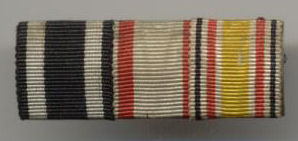
Photo © JW Collection
The medals on this bar in order of seniority
from left to right are-
Prussian Iron Cross, second class
Hessian General Decoration
1900-01 China
Campaign Medal
The
original owner of this miniature ribbon bar was a Hessian veteran of the
Boxer Rebellion and the First World War.
|
|
| |
|
|
| |
|
|
| |
|
|
| |
Bar with
the China Medal

Photo © JW Collection
The medals on this bar in order of
seniority from left to right are-
Prussian Iron
Cross, second class
Saxon Friedrich August Medal
1914-18 Honour Cross with swords
1900-01 China Campaign Medal
Saxon Long Service Award
The original owner of this miniature ribbon bar was a Saxon veteran
of the Boxer Rebellion and the First World War.
|
|
| |
|
|
| |
|
|
| |
|
|
| |
Bar with
the China Medal

Photo © JW Collection
The medals on this bar in order of
seniority from left to right are-
Prussian Iron Cross, second class
Hamburg Hanseatic Cross
Saxon Albert Order Knights
Cross, second class with swords
Austro-Hungarian Officers Merit
Cross
1914-18 Honour Cross with swords
1900-01 China Campaign Medal
Prussian Wilhelm I Centenary Medal
The original owner of this miniature ribbon bar was an officer
veteran of the Boxer Rebellion, the Herero Rebellion and the First
World War. Note that he
wears his
Austro-Hungarian Military Merit Cross, probably earned in the First
World War, ahead of some German awards whereas imperial era regulations stated
that foreign medals should be worn after all German medals. This bar
was probably made after 1938 when Austria was annexed into
the German Reich, therefore Austrian medals were no longer
classed as foreign.
|
|
| |
|
|
| |
|
|
| |
|
|
| |
Bar with the China Medal

Photo © JW Collection
The medals on this bar in order of
seniority from left to right are-
Prussian Order of the
Red Eagle, third or fourth class
Prussian
Officers Long Service Award, for 25 years service
1900-01
China Campaign Medal
Prussian Wilhelm I
Centenary Medal The original owner of this
miniature ribbon bar
was an officer
veteran of the Boxer Rebellion.
|
|
| |
|
|
| |
|
|
| |
|
|
| |
Bar with
the China Medal

Photo © JW Collection
The medals on this bar in order of
seniority from left to right are-
1939 War Merit Cross, second class with swords
1914-18 Honour Cross for non-combatants
1900-01 China Campaign Medal
Prussian Merit Cross for War
Aid
Prussian Long Service Award
The original owner of this miniature ribbon bar was a veteran of the
Boxer Rebellion and a non-combatant in the First World War.
|
|
| |
|
|
| |
|
|
| |
|
|
| |
Bar with
the China Medal

Photo © JW Collection
The medals on this bar in order of
seniority from left to right are-
Prussian Iron Cross, second class
Saxon Friedrich August Medal
with swords
1914-18 Honour Cross with swords
Prussian Long Service Award
1900-01 China Campaign Medal
The original owner of this miniature ribbon bar was a veteran of the
Boxer Rebellion and the First World War.
|
|
| |
|
|
| |
|
|
| |
|
|
| |
Bar with
the China and South West Africa Medals

Photo © JW Collection
The medals on this bar in order of
seniority from left to right are-
Prussian Iron Cross,
second class
Hamburg Hanseatic Cross
1914-18 Honour Cross with swords
1900-01 China Campaign Medal
1904-08 South West Africa Campaign Medal
Prussian General
Honour
Decoration, second class
Third Reich Faithful Service Cross for 40 years service
The original owner of this miniature ribbon bar was a veteran of the
Boxer Rebellion, the Herero Rebellion and the First World War.
|
|
| |
|
|
| |
|
|
| |
|
|
| |
Two Bars with
the China and Colonial Medals
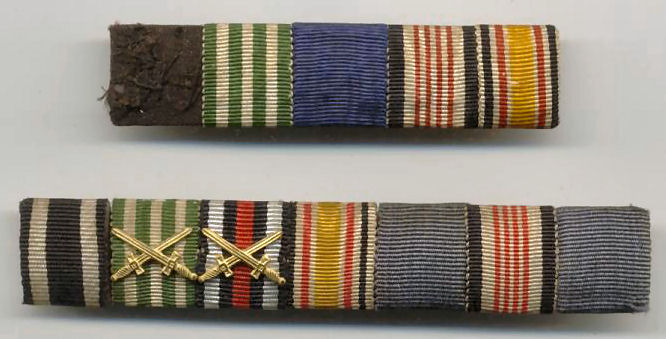
Photo © JW Collection
The medals on these bars are worn in
slightly different orders of
seniority. The top bar is from left to right-
Prussian Iron Cross,
second class (missing the ribbon on this bar)
Saxon Honour Cross with
swords (missing the swords on this bar)
Prussian Long Service Award
Colonial Service Medal
1900-01 China Campaign Medal
The lower bar with later
awards is from left to right-
Prussian Iron Cross, second class (missing the
ribbon on this bar)
Saxon Honour Cross
with swords
1914-18 Honour Cross
with swords
1900-01 China Campaign Medal
Prussian Long
Service Award
Colonial Service Medal
Prussian Landwehr Long Service
Award
The original owner of this miniature ribbon bar was a
Saxon veteran of the
Boxer Rebellion, an unspecified colonial campaign and the First World War.
Before 1935 long service medals were worn ahead of campaign
medals (as correctly seen on the top bar), from 1935 this
rule was changed to put pre-1914 campaign medals ahead of
long service awards. Strangely this veteran has alternated
them on his later bar.
|
|
| |
|
|
| |
|
|
| |
|
|
| |
Bar with the China Medal and
a Finnish
Award

Photo © Christophe Deruelle
The medals on this bar
in order of seniority from left to right are-
Prussian Iron Cross,
second class
1914-18 Honour Cross with swords
Finnish Cross of Liberty,
third or fourth class
1900-01 China Campaign Medal
Prussian Order of the
Red Eagle, third or fourth class
Prussian
Officers Long Service Award, for 25 years service
Prussian Wilhelm I
Centenary Medal
The original owner of this
bar was an officer veteran of the Boxer Rebellion and the
First World War. The Finnish Cross of Liberty was probably
awarded for serving in the Finnish Civil War of 1918 as part
of the German Baltic Sea Division. Curiously it is worn
ahead of several German awards, whereas regulations stated
that foreign medals always be worn behind German medals on a
bar. The position of the Red Eagle Order behind his First
World War medals shows that it was awarded before 1914,
quite possibly for service in the Boxer Rebellion. It is
more likely to have been a fourth class award, as the third
class award was usually accompanied by an award of the Crown
Order, third class. |
|
| |
|
|
| |
|
|
| |
|
|
| |
Bar with the Lion
Order
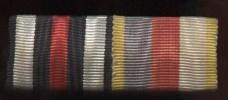
Photo by Joachim Specht on
WikiCommons
The medals on this bar
in order of seniority from left to right are-
1914-18 Honour Cross
Lion Order, second class
The original
owner of the this bar served in the First World War in a
role that assisted the colonies. The Lion Order was a
semi-official award given to combatants in the colonies as a
breast badge and a chest medal with ribbon (as seen here) as
a second class award for those that helped the colonial war
effort back home in Germany. The Honour Cross was instituted
in 1934 and semi-official awards such as the Lion Order were
banned in 1935, so this either accurately dates this ribbon
bar or shows that the wearer was not conforming to
regulations. |
|
| |
|
|
| |
|
|
| |
|
|
| |
Bar with the China Medal and
an Ottoman
Award

Photo © JW Collection
The medals on this bar in order of
seniority from left to right are-
Hessian War
Decoration
1900-01
China Campaign Medal
Bavarian Red Cross Medal or more probably the
Bulgarian
Bravery Cross
Saxe-Weimar Order of the White Falcon Knights Cross or more
probably an unidentified
pre-1914 Austro-Hungarian Award
Turkish War Medal
The original owner of this miniature ribbon bar was a Hessian
veteran of the Boxer Rebellion and the First World War,
when he probably served alongside the Ottoman army in the Middle
East. Note that this style of folded ribbon bar was common in the
South German states.
|
|
| |
|
|
| |
|
|
| |
|
|
| |
Two Bars with Ottoman
Awards
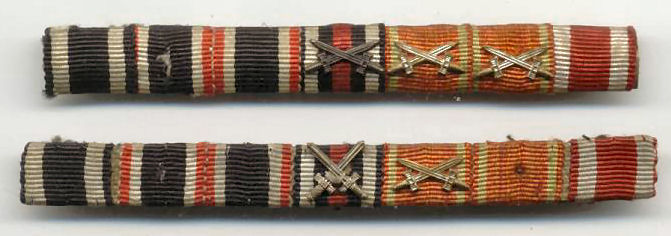
Photo © JW Collection
The medals on these two bars in order of
seniority from left to right are-
Prussian Iron Cross,
second class
1939 War Merit Cross
with swords (the swords are unfortunately missing on
both bars)
1939 War Merit Cross
without swords
1914-18 Honour Cross
with swords
Ottoman Liyakat Merit
Medal, first class in silver with swords
Ottoman Liyakat Merit
Medal, second class in silver with swords (the
swords are missing on the lower bar)
Ottoman War Medal
The original owner of these
two miniature ribbon bars was a naval
veteran of the First World War,
who may have served on board either the SMS Goeben or SMS Breslau in
the Ottoman Navy in the First World War. The two
Ottoman Liyakat Medals both have silver swords and look
identical as ribbons in both first and second class. It is
also curious that he has the 1939 War Merit Cross in both
the combatant (with swords) and non-combatant (without
swords) awards. |
|
| |
|
|
| |
|
|
| |
|
|
| |
Bars and Buttonhole
with an Ottoman Award
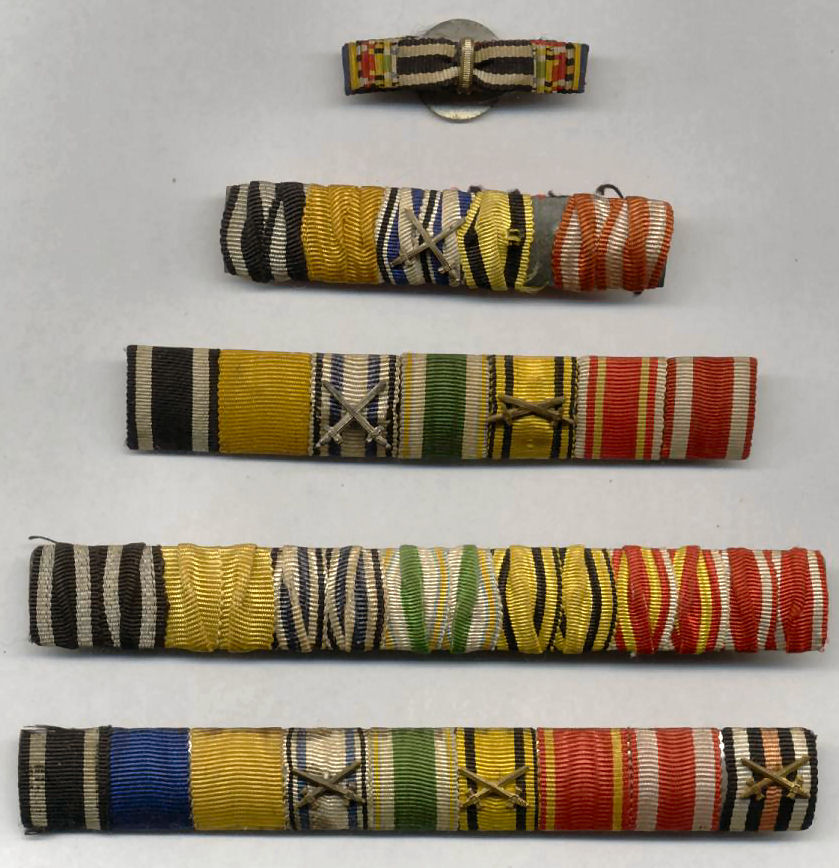
Photo © JW Collection
This collection of miniature ribbon bars and a
buttonhole miniature probably belonged to a South German naval officer who
may have served on board either the SMS Goeben or SMS Breslau in the Ottoman
Navy in the First World War.
The First Ribbon Bar shows five medals in order of seniority
from left to right-
Prussian Iron Cross, second class
Prussian
Wilhelm I 1897 Centenary Medal
Bavarian Military Merit Cross, second class (or
Bavarian Order of Military Merit,
fourth class) with swords
Württemberg Wilhelm Cross, second class with swords (this
ribbon is missing its swords)
Ottoman War Medal
The fact that he was been awarded South German
medals leads one to conclude he is from a South German state, yet he wears
his medals in Prussian order of precedence (with the Centenary Medal ahead
of the Bavarian and Wurttemberg crosses). This points to him serving in an
imperial unit such as the navy (or less likely the Schutztruppe). The award
of an Ottoman War medal hints that he probably served there during the First
World War. The majority of German naval personnel in the Ottoman Empire were
serving either on the SMS Goeben or SMS Breslau (though other German naval
officers served as staff and training officers). Ths bar dates from either
the later years of the First World War (post 1915 when the Ottoman War Medal
was instituted) or shortly after the war.
The Second Ribbon Bar shows seven medals,
the two additional being-
Saxon War Merit Cross (between the
Bavarian and Württemberg awards)
Baden War Merit Cross (between the Württemberg and Ottoman awards)
The Saxon War Merit Cross was a curious medal
in that it could only be awarded in the absence of any other Saxon medals.
If the recipient later earned another Saxon medal, the War Merit Cross had
to be returned. The Saxon cross was instituted in 1915 and the Baden Cross
in 1916, thus dating the bar to later years of the First World War or
shortly after the war.
The Third Ribbon Bar has the same medals but
worn South German style with the ribbons folded out and without swords.
Naval regulations authorised medals to be worn Prussian style with the
ribbons flat. This may indicate that the medal bar was for wear in civilian
life amongst other South Germans after the war.
The Fourth Ribbon Bar shows nine
medals, the two additional being-
Prussian Officers Long Service Award,
for 25 years service (between the Iron Cross and the Centenary Medal)
1914-18 Honour Cross with swords for
combatants (after the Ottoman War Medal)
Since the original owner had been
in service since 1897 (and probably done some of those years on overseas
service which counted for double years) the Long Service Award must be
an officer's award for 25 years rather than a nine year other ranks
award. The Honour Cross was instituted in 1934 and it is interesting to
see the medals worn Prussian (or naval style again), perhaps the owner
was recalled to service in the expanding Kriegsmarine of the late
1930's. It is curious to note that he wears the Honour Cross behind his
Ottoman award whereas all German awards usually had precedence over
foreign awards.
The Buttonhole Miniature shown at the
top has ten medals, the additional being another long service award
(possibly a Third Reich Faithful
Service Award). |
|
| |
|
|
| |
|
|
| |
|
|
| |
Bar with Ottoman
Awards

Photo © JW Collection
The medals on this bar in order of
seniority from left to right are-
Prussian Iron Cross,
second class
1939 War Merit Cross
without swords
1939 War Merit Cross
without swords
Ottoman Liyakat Merit
Medal, first class in gold with swords
Ottoman Liyakat Merit
Medal, second class in gold with swords
Ottoman War Medal
The original owner of this miniature ribbon bar was a naval
petty officer in the First World War,
when he on served on the SMS Emden. The bar came from a
large collection of SMS Emden material in Vienna. Judging by the
Ottoman awards, this sailor was probably part of
Kapitänleutnant von Mücke's
detachment which made its way across the Indian Ocean after the
Emden had been sunk. They were eventually picked up by Ottoman
troops in the Arabian desert.
either the SMS Goeben or SMS Breslau. The two
Ottoman Liyakat Medals both have silver swords and look
identical as ribbons in both first and second class. It is
also curious that he has the 1939 War Merit Cross in both
the combatant (with swords) and non-combatant (without
swords) awards. |
|
| |
|
|
| |
|
|
| |
|
|
| |
Bar and
Buttonhole with the China Medal


Photo © JW Collection
The medals on the
ribbon bar in order of
seniority from left to right are-
Prussian
Iron Cross, second class
Saxon Albert Order
Knights Cross, second class with swords
Prussian Crown Order
Prussian Long
Service Medal
1900-01 China Campaign Medal
Prussian Wilhelm I Centenary Medal
The original owner
of this miniature ribbon bar and buttonhole badge ("Knopflochschnalle") was a veteran of the Boxer Rebellion
and the First World War. Note
the buttonhole was
made after 1934 (when the 1914-18 Honour Cross seen on it was
instituted). The miniature ribbon bar is pre-1934.
|
|
| |
|
|
| |
|
|
| |
|
|
| |
Buttonhole
Miniature with the South West
Africa Medal

Photo © JW Collection
This buttonhole includes the ribbons for-
1914-18 Honour Cross with swords
Saxe-Ernestine House Order Medal
1904-08 South West Africa Campaign Medal
Prussian Long Service Award
The original owner of this miniature ribbon bar was a veteran of the
Herero Rebellion and the First World War.
|
|
| |
|
|
| |
|
|
| |
|
|
| |
Buttonhole Miniature with the China Medal
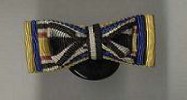
Photo © JW Collection
This buttonhole includes the ribbons for-
Prussian Iron Cross, second class
1900-01
China Campaign Medal
Prussian
Long Service Award
Prussian Wilhelm I
Centenary Medal
The original owner
of this miniature ribbon
bow badge was
a veteran of the Boxer Rebellion and the First World War.
|
|
| |
|
|
| |
|
|
| |
|
|
| |
Buttonhole Miniature with the South West
Africa Medal

Photo © JW Collection
This buttonhole includes the ribbons for-
Saxon Order of St Henry,
Knights Cross
Saxon Albert Order,
Knights Cross second class
Prussian Iron Cross, second class
1904-08 South West Africa Campaign Medal
Hessian General
Decoration
Saxe-Weimar General
Decoration
Ottoman War Medal
The original owner
of this miniature buttonhole badge was a Saxon veteran of the Herero
Rebellion and the First World War, when he probably served alongside
the Ottoman army in the Middle East. |
|
| |
|
|
| |
|
|
| |
|
|
| |
Buttonhole Miniature with the South West
Africa Medal
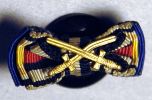
Photo © Chris Handisides Collection
This buttonhole includes the ribbons for-
1914-18
Honour Cross with
swords for combatants
1900-01
China Campaign Medal
Prussian Long Service Award
The original
owner of this miniature buttonhole badge was a veteran of
the Boxer Rebellion and the First World War, |
|
| |
|
|
| |
|
|
| |
|
|
| |
Buttonhole Miniature of the China Medal

Photo © JW Collection
This miniature
buttonhole badge is of
the 1900-01
China Campaign Medal, showing the original owner to be a veteran
of the Boxer Rebellion.
|
|
| |
|
|
| |
|
|
| |
|
|
| |
Buttonhole Miniature with an SMS Emden
Commemorative Medal
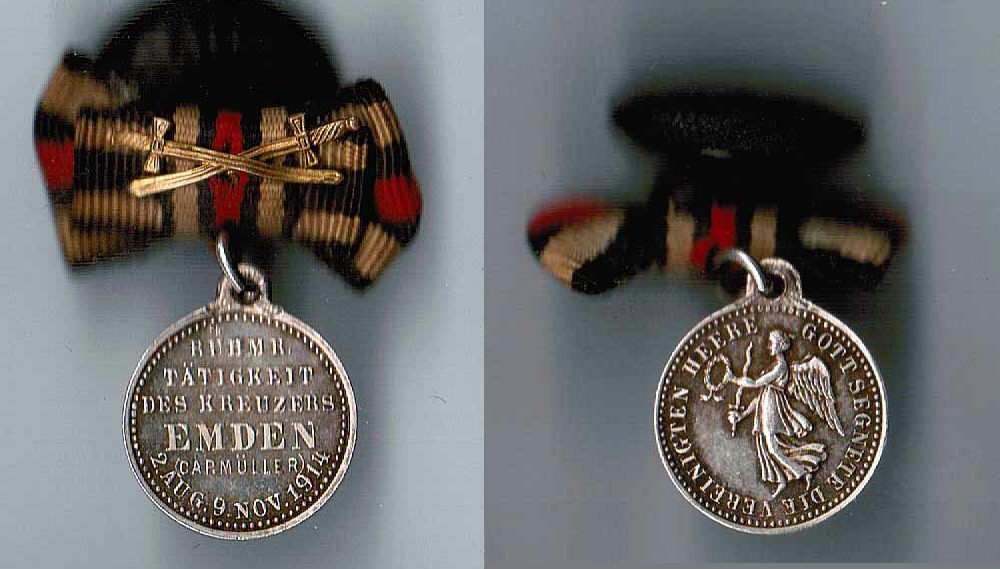
Photo ©
Captain George Albert
This miniature
buttonhole badge has the ribbons of the-
Prussian Iron Cross,
second class
1914-18 Honour Cross
with swordsThe
medal hanging below is an unofficial commemorative award for service on the SMS
Emden, under Korvettenkapitän Karl von Müller. The light
cruiser SMS Emden, set sail from Tsingtao at the
outbreak of war to cause mayhem amongst entente shipping
in the Indian Ocean and bombarding enemy ports
(including Madras in British India) during the early
months of the war. The allies put vast efforts into
catching the SMS Emden (at one point having over 60
warships involved in the search) but she eluded them,
capturing and sinking thousands of tons of Entente
shipping along the way. In November 1914 she was finally
cornered off Direction Island and sunk by the Australian
light cruiser HMAS Sydney.
But the voyage of the Emden's crew did not end there, while most of the crew were captured
when the ship sank, a landing party that had been on Direction Island to destroy the radio
mast evaded capture.
They were now stranded but managed to make their way back to Germany on an epic
journey, firstly across the Indian Ocean (in a captured three masted schooner,
the Ayesha), then after landing on the Red Sea coastline they trekked
across the desert fighting hostile Arab tribesmen along the way until picked up
by Ottoman troops. They arrived in Istanbul to a hero's welcome in May 1915,
travelling on to Germany from there. The surviving crew of the SMS Emden were
uniquely honoured for their bravery by being allowed to add the suffix "-Emden" to
their surnames. To this day some of their descendants still carry this
additional name.
Recommended External Link -
History Net page on the
SMS Emden
|
|
| |
|
|